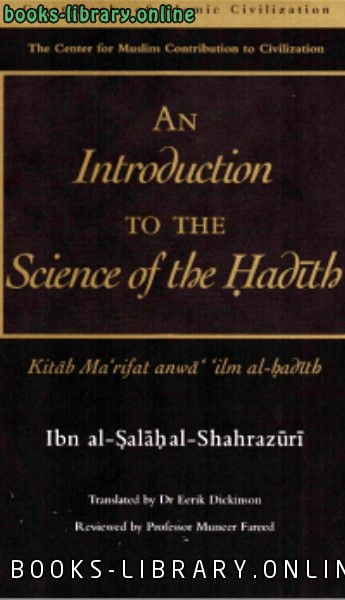📘 قراءة كتاب An Introduction to the Science of Hadeeth أونلاين


(Ibn al-Ṣalāḥ's) Introduction to the Science of Hadith ( Arabic : مقدمة ابن الصلاح في علوم الحديث , romanized : Muqaddimah ibn al-Ṣalāḥ fī 'Ulūm al-Ḥadīth ) is a 13th-century book written by `Abd al-Raḥmān ibn `Uthmān al-Shahrazūrī, better known as Ibn al-Ṣalāḥ , which describes the Islamic discipline of the science of hadith , its terminology and the principals of biographical evaluation . A hadith is a recorded statement, action or approval of the Islamic prophet Muhammad which serves as the second source of legislature in Islamic law . The science of hadith that this work describes contains the principles with which a hadith specialist evaluates the authenticity of individual narrations.
Introduction to
the Science of Hadith
Arab. Ms.JPG
Sample of older Arabic text
Author
Ibn al-Ṣalāḥ
Original title
Muqaddimah ibn al-Ṣalāḥ
Translator
Dr. Eerik Dickinson
Country
Syria
Language
Arabic
Series
Great Books of Islamic Civilization
Subject
Science of hadith , hadith terminology and biographical evaluation
Publisher
Garnet Publishing Limited
Publication date
1236 CE/634 AH
Published in English
2006
Pages
356
ISBN
1-85964-158-X
The Introduction comprises 65 chapters, each covering a hadith related issue. The first 33 chapters describe the various technical terms of hadith terminology which describe the conditions of a hadith's authenticity , or acceptability as a basis for Islamic jurisprudence . The following chapters relate to the isnād , or chain of narration . Next are a series of chapters pertaining to the etiquette to be observed by hadith scholars and manners of transcription. The last chapters describe various issues relating to the narrators of hadith including naming conventions.
Ibn al-Ṣalāḥ began the Introduction as a series of lectures he dictated to his students in Damascus ending in 1233. It has received considerable attention from subsequent authors who explained, abridged and set it to poetry and it became an example for latter books of its genre. The Introduction has been published a number of times in its original Arabic and has also been translated into English.
Contents
Title
As the Introduction was not officially named by the author, there exists some speculation as to its actual title, with different possibilities suggested. al-Dhahabī referred to it as `Ulūm al-Ḥadīth , The Sciences of Hadith , as did Ibn Ḥajr and Muḥammad ibn Ja`far al-Kattānī. [3]
`Āʼishah bint `Abd al-Raḥmān said in the foreword of her edition of the Introduction :
His book about the sciences of hadith is the best known of his works without comparison, to the extent that it is sufficient to say, the Book of Ibn al-Ṣalāḥ , the intent being understood due to its popularity and stature. With the previous scholars, its subject matter overcame it, thus being referred to as, the Book of Ibn al-Ṣalāḥ about `Ulūm al-Ḥadīth or as he referred to it in its opening pages, the Book of Familiarity with the Types of `Ulūm al-Ḥadīth . It has become well known as of late as: Muqaddimah Ibn al-Ṣalāḥ fi `Ulūm al-Ḥadīth , Ibn al-Ṣalāḥ's Introduction to the Sciences of Hadith .
Nūr al-Dīn `Itr, in the introduction to his edition of the Introduction , concluded that its actual name is either ʻUlūm al-Ḥadīth ( The Sciences of Hadith ) or Ma`rifah Anwā`i `Ilm al-Ḥadīth ( Familiarity with the Types of the Science of Hadith ). This is based upon the author's own usage in his own introduction in addition to the usage of other scholars in the centuries after the authoring of the book. Similar to Bint `Abd al-Raḥmān, he acknowledged that the book is most commonly referred to as Muqaddimah Ibn al-Ṣalāḥ ( The Introduction of Ibn al-Ṣalāḥ ).
Overview
al-`Irāqī described the Introduction as "the best book authored by a hadith specialist in defining its terminology ."
Origin
Books of hadith terminology passed through two developmental phases. The first was the compilation of the statements of earlier scholars, quoting the expressions they had used without evaluating those terms or suggesting terms applicable to those expressions. This was the methodology adopted by earlier scholars such as Yaḥyā ibn Ma`īn , `Alī ibn al-Madīnī , Muslim ibn al-Ḥajjāj , al-Tirmidhī in their works. The second phase consisted of books based upon and evaluating those of the first phase. Their authors cited the quoted statements of the earlier works and began the arrangement and codification of relevant terms. Principles were established and, for the most part, accepted, with individualized terms exclusive to particular scholars explained in context. Examples of books authored in this manner are: Ma`rifah `Ulūm al-Ḥadīth by al-Ḥākim , Al-Kifāyah by al-Khaṭīb al-Baghdādī and the Introduction of Ibn al-Ṣalāḥ.
The Introduction finds its origins in the books of al-Khaṭīb al-Baghdādī, [8] who authored numerous books on the various disciplines of the science of hadith , upon which all latter scholars in the discipline were indebted. [8] In particular, he focused on al-Khaṭīb's al-Kifāyah as he viewed it as comprehensive of the various disciplines of the science of hadith.
The book began as a series of lectures Ibn al-Ṣalāḥ delivered at the Ashrafiyyah School in Damascus . In these lectures he dictated its contents piecemeal to his students. He began delivering the lectures on Friday, June 17, 1233 CE/630 AH, his first lecture delivered in that school, and completed them at the end of September or the beginning of October of the year 1236/634. The Introduction was either transcribed or memorized by those students in attendance.
It was in a similar manner that the Introduction was disseminated. Al-Dhahabī named a number of scholars who conveyed it directly from Ibn al-Ṣalāḥ, the majority of whom then authorized al-Dhahabī to do so as well. Similarly, al-`Irāqī mentioned two scholars who conveyed it to him from Muḥammad ibn Yūsuf al-Muḥtar, a student of Ibn al-Ṣalāḥ, [6] as did Ibn Ḥajr, who mentioned his isnād (chain of narration) to it, also having conveyed it from two of his own teachers
Book author : Ibn alSalah alShahrazuri
حجم الكتاب عند التحميل : 19.9 ميجا بايت .
نوع الكتاب : pdf.
عداد القراءة:
اذا اعجبك الكتاب فضلاً اضغط على أعجبني و يمكنك تحميله من هنا:

شكرًا لمساهمتكم
شكراً لمساهمتكم معنا في الإرتقاء بمستوى المكتبة ، يمكنكم االتبليغ عن اخطاء او سوء اختيار للكتب وتصنيفها ومحتواها ، أو كتاب يُمنع نشره ، او محمي بحقوق طبع ونشر ، فضلاً قم بالتبليغ عن الكتاب المُخالف:
 قبل تحميل الكتاب ..
قبل تحميل الكتاب ..
يجب ان يتوفر لديكم برنامج تشغيل وقراءة ملفات pdf
يمكن تحميلة من هنا 'http://get.adobe.com/reader/'


 منصّة المكتبة
منصّة المكتبة 